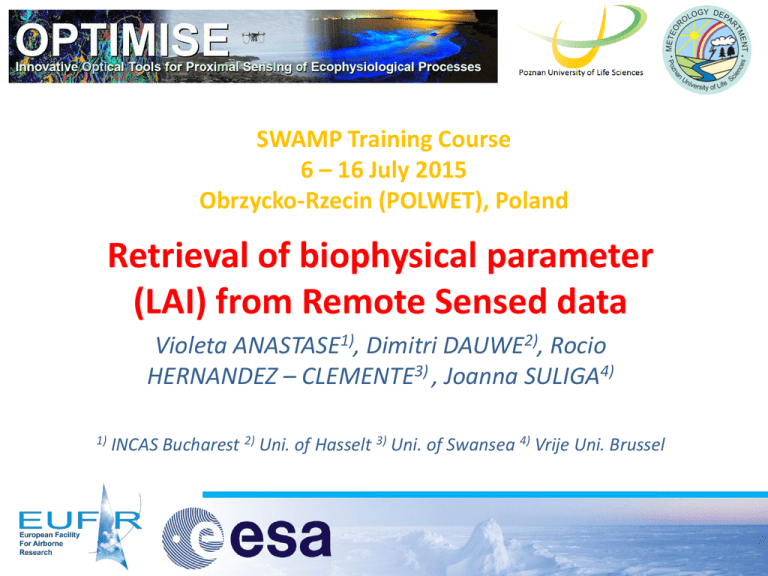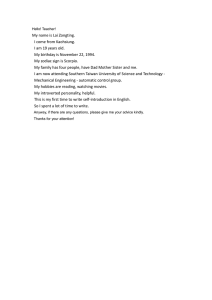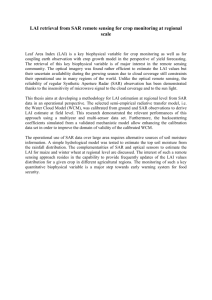Retrieval of biophysical parameter (LAI) from Remote Sensed data
advertisement

SWAMP Training Course 6 – 16 July 2015 Obrzycko-Rzecin (POLWET), Poland Retrieval of biophysical parameter (LAI) from Remote Sensed data Violeta ANASTASE1), Dimitri DAUWE2), Rocio HERNANDEZ – CLEMENTE3) , Joanna SULIGA4) 1) INCAS Bucharest 2) Uni. of Hasselt 3) Uni. of Swansea 4) Vrije Uni. Brussel SUMMARY Objectives Presentation of the research site Ground measurements: methods & results Airborne measurements: methods & results Conclusions Objectives Retrieval of biophysical parameter (LAI) from Remote Sensed data Spectral Imaging with UAV (Ricola) Hyperspectral measurements with SVC (SpectraVista) LAI measurements with SunScan FOCUS on LAI • Simulations and validation SUMMARY Objectives Presentation of the research site Ground measurements: methods & results Airborne measurements: methods & results Conclusions RESEARCH SITE Rzecin site (POLWET) Field campaign: 11.07.2015 8 plots 4 vegetation classes Carex elata B20 Typha latifolia B21 Mosses and small Carex B25 - 27 Equisetum fluviatilis Menyanthes trifoliate B22 - 24 SUMMARY Objectives Presentation of the research site Ground measurements: methods & results Airborne measurements: methods & results Conclusions LAI / f APAR measurements LAI • One average value • Calculated by model fAPAR (mode „All”) Instrument SunScan • 64 values • One sample = 3 measures (below, above, up-sidedown) LAI / f APAR measurements Radiation readings of SunScan (mode „all”) Radiation 2000 1500 1000 500 0 0 10 20 30 40 50 60 70 No. of sensors Transmitted Incident B20 – Carex elata Reflected Radiation 2000 1500 1000 500 0 0 10 20 30 40 50 60 70 No. of sensors Transmitted Incident Reflected B23 – Carex elata LAI / f APAR measurements Plot LAI f APAR Cor (LAI;f APAR) I_dif 20 21 22 23 24 25 26 27 4,8 3,5 1,7 2,3 1,4 0,9 0,4 0,5 0,93 0,84 0,68 0,51 0,20 0,12 0,06 0,05 0,60 0,72 0,27 -0,89 -0,73 0,84 0,88 0,55 0,14 0,15 0,14 0,17 0,14 0,14 0,14 0,14 Ground Measurements The spectral measurements were achieved using the SpectraVista HR1024i spectrometer. For each ground target were achieved 9 samplings in three different points, to highlight the vegetation characteristics. www.spectravista.com Spectra Vista Results – Vegetation Reflectances Averaged reflectance - Speccio SCOPE simulation SpectraVista Results – Measurements Vs. Simulations Canopy Retrieval SUMMARY Objectives Presentation of the research site Ground measurements: methods & results Airborne measurements: methods & results Conclusions Airborne Measurements UAV imaging with Ricola Flight pattern for the first flight: • • • • • Starting time: 09.21 am (UTC time) Starting point: near the 26th target Ending point: near the Eddy covariance tower Number of target points: 19 GPS coordinates: N 52° 45’ 42,3’’, E 016° 18’ 34,6’’ • Flight lines: 4 • Flight length: 180 m • Equipment: Ricola camera, Hyperspectral camera Flight pattern for the second flight: • • • • • • • • Starting time: 01.08 pm (UTC time) Starting point: near the 20th ground target Ending point: near the 24th ground target Number of target points: 18 GPS coordinates: N 52° 45’ 33,6’’, E 016° 18’35,6’’ Flight lines: 4 Flight length: 170 m Equipment: Ricola camera, Hyperspectral camera Flight trajectory Covered Area Image Spectral Information Ricola Images Modelling with ARTMO LUT-based inversion of physically based radiative transfer model (RTM) Used model: 4sail (LAI) Look-up tables (LUT) 10000 simulations Results of mapping Leaf Area Index (LAI) with ARTMO LAI Validation points B25 LAI from 0,6 to 1,3 mean = 0,9 B26 LAI from 0,3 to 0,6 mean = 0,4 Validation points B25 LAI from 0,6 to 1,3 mean = 0,9 B26 LAI from 0,3 to 0,6 mean = 0,4 Cross-Validation Statistics Pearson RMSE Shannon Statistics Noise RMSE Pearson chisquare Shannon entropy # % train samples ME RMSE RELRMSE NRMSE MAE R R2 R2adj NSE Speed [s] 5 5 500 500 5 -0,20 5 0,39 0,29 0,47 25,16 40,56 28,76 46,35 0,23 0,42 0,51 0,26 0,04 0,00 0,18 -0,11 -0,34 -2,47 0,05 0,05 5 500 5 0,52 44,71 51,09 0,48 0,18 0,03 -0,08 -3,22 0,08 0,46 SUMMARY Objectives Presentation of the research site Ground measurements: methods & results Airborne measurements: methods & results Conclusions Conclusions 1. Wetlands can be characterized with high heterogenity therefore a high spatial variability of reflectance or biophysical parameters (e.g. LAI) can be observed 2. Biophysical parameters (e.g. LAI) can be sucessfuly (error < 30%) mapped with LUT-based inversion of RTM and airborne (UAV) hyperspectral data 3. Improvement of modelling can be achieved by collecting more groundtruth data of plant functional traits (PFT) SWAMP Training Course 6 – 16 July 2015 Obrzycko-Rzecin (POLWET), Poland A big thank you goes out to EUFAR, OPTIMISE and the enthousiast team of trainers and trainees!


